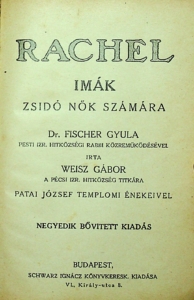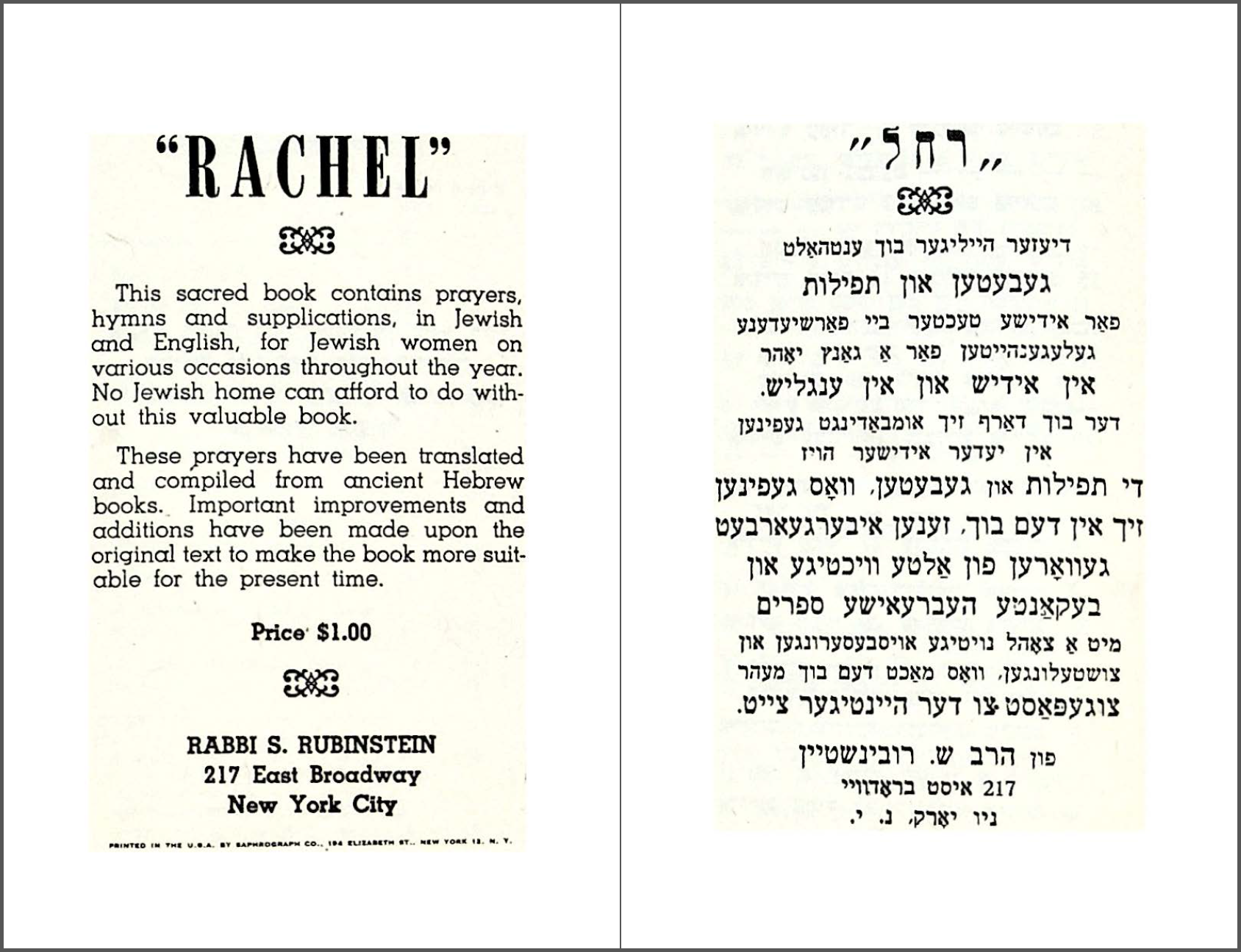Prayers in Magyar for Jewish women by Gyula Fischer and József Patai. This collection was bound together with a Hebrew-Magyar prayerbook by Rabbi Gabor Weisz from 1883.


“📖 Rachel: Imák Zsidó Nők Számára, by Gyula Fischer with József Patai (1908)” is shared through the Open Siddur Project with a Creative Commons Public Domain Dedication 1.0 Universal license.
József Patai (1882–1953), poet, scholar, and Zionist leader. In his life and work, József Patai is representative of the first generation of Hungarian Zionist intellectuals. He changed his name from Klein to Patai after his birthplace, Gyöngyöspata, a small village in northern Hungary. Patai’s father was a grocer and Talmudic scholar, a follower first of the rebbe of Belz and then of the rebbe of Satmar. It was this world that Patai depicted in his lyrical social study, his most enduring prose work, A középső kapu (1927; new ed., 1998 [published in English as The Middle Gate; 1994]). (from his article by YIVO)
Gyula Fischer (also Julius Fischer; 1861–1944), Hungarian scholar and rabbi, Born in Sárkeresztur, Fischer studied at the Budapest rabbinical seminary and was appointed rabbi of Györ (Raab) in 1887, Prague in 1898, and Budapest (1905) where he was chief rabbi (1921–43). In 1905 he became lecturer in rabbinic literature and Midrash at the rabbinical seminary, and for a time was acting director of the seminary. A man of wide Jewish and general erudition, Fischer wrote a monograph on Judah ibn Tibbon (1885) and translated into Hungarian Philo's Life of Moses (1925). He contributed many articles and essays in German and Hungarian to Jewish and general periodicals. Fischer was a gifted orator and one of the first Hungarian Neolog rabbis to support the rebuilding of Erets Israel.
Gábor Weisz (b.1857 Albertirsa - d. 1943 Pécs) served his community as a teacher and as a herald of youth worship, secretary and deputy rabbi of the Ḥevrah Kadishah (1888–1889, 1914–1920). From his settlement in Pécs he was the secretary of the community (1888–1943). He completed his rabbinical studies in the yeshiva of Hőgyész (Tolna m.), Dr. Ármin Perls in Pécs he continued his education in the theological sciences alongside the chief rabbi. He published Rachel, a prayer book for women (1883) and A Textbook for the History of the Jewish People for Israelite students in folk and civil schools. He was a member of the editorial board of the Jewish Lexicon. He compiled and published a list of his master's literary work, Memory of Ármin Perls, and wrote the history of the community of Pécs: The monograph of the Jewish community of Pécs (1929). In his work Visiting the Jewish Cemetery in Pécs, he remembered the famous personalities resting in the Jewish cemetery.
Aharon Varady, founding director of the Open Siddur Project, is a copyright researcher and amateur book scanner. He prepares digital images and new digital editions of prayer books and related works in the Public Domain in order to make their constituent parts (prayers, translations, annotations, etc.) publicly accessible for collaborative transcription by project volunteers. (In some cases, he finds existing digital editions prepared by others that require correction and reformatting.) If you appreciate his efforts, please send him a kind note or contribute to his patreon account.
Stable Link:
https://opensiddur.org/?p=31314
Associated Image:


Title page of Rachel – imák zsidó nők számára (Julius Fischer, Gábor Weisz, József Patai 1908)
(This image is set to automatically show as the "featured image" in shared links on social media.)
Re-formatted:
ODT
Terms of Use:
Be a mentsch (a conscientious, considerate person) and adhere to the following guidelines:
- Properly attribute the work to József Patai, Gyula Fischer, Gabor Weisz and Aharon N. Varady (digital imaging and document preparation).
- Clearly indicate the date you accessed the work and in what ways, if any, you modified it. (If you have adapted the work, let us know so that the contributor might consider endorsing your revision.)
- Provide the stable link to this resource: <https://opensiddur.org/?p=31314>.
- Indicate that the original work was shared under the Creative Commons Zero (CC 0) Universal license a Public Domain dedication. (To redistribute or remix this work in any format, modified or unmodified, you must refer to the terms of the license under which the work is shared.)
Additional Notes:
- The views expressed in this work represent the views of their creator(s) and do not necessarily represent the views of the Open Siddur Project's developers, its diverse community of volunteer contributors, or its institutional partners.
- We strongly advise against printing sacred texts and art containing divine names as these copies must be regarded with reverence, complicating their casual treatment and disposal.
- If you must dispose of a printed sacred text (one containing Divine Names), please locate the closest genizah (often established by a synagogue) and contact its custodians for further instructions. We also recommend using Morah Yehudis Fishman's Prayer for Adding a Work to the Genizah.
Support this work:
The Open Siddur Project is a volunteer-driven, non-profit, non-commercial, non-denominational, non-prescriptive, gratis & libre Open Access archive of contemplative praxes, liturgical readings, and Jewish prayer literature (historic and contemporary, familiar and obscure) composed in every era, region, and language Jews have ever prayed. Our goal is to provide a platform for sharing open-source resources, tools, and content for individuals and communities crafting their own prayerbook (siddur). Through this we hope to empower personal autonomy, preserve customs, and foster creativity in religious culture.
ויהי נעם אדני אלהינו עלינו ומעשה ידינו כוננה עלינו ומעשה ידינו כוננהו "May the pleasantness of אדֹני our elo’ah be upon us; may our handiwork be established for us — our handiwork, may it be established." –Psalms 90:17









Leave a Reply